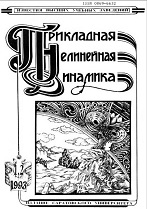|
|
Izvestiya VUZ. Applied Nonlinear Dynamics, 2016, Volume 24, Issue 5, Pages 37–61
(Mi ivp200)
|
 |
|
 |
APPLIED PROBLEMS OF NONLINEAR OSCILLATION AND WAVE THEORY
Entropy and DFA of heart rate variability in remote ischemic preconditioning, orthostatic test in healthy young subjects and in individuals with changes in autonomic regulation of cardiodynamics
A. N. Fleishmana, T. V. Korablinab, E. S. Smaginab, S. A. Petrovskiya, D. E. Iovenb, A. A. Neretinb
a Research Institute for Complex Problems of Hygiene and Occupational diseases
b Siberian State Industrial University
Abstract:
There was conducted the research of comparative physiological assessment in nonlinear analysis methods of heart rate variability (HRV): the approximate entropy (ApEn), sample entropy (SampEn), multiscale entropy (MSE) and detrended fluctuation analysis (DFA) in case of remote ischemic preconditioning (RIPC) and orthostatic test both in healthy young subjects and individuals with autonomic regulation imbalance. The purpose of this work was to raise awareness of the researches as well as disclosing the mechanisms of non-pharmacological methods in heart and brain protection from damage and stress.
The main tasks included: 1) a model study of the relations between amplitude and structural HRV features regarding the entropy indexes and DFA; 2) a comparative study in the properties of ApEn, SampEn, MSE of heart rate variability (HRV); 3) the research of many features of entropy and DFA indicators of HRV in the context of RIPC, orthostatic test and autonomic regulation changes.
The artificially generated wave signals were used in the model studies. It was revealed that the changes in amplitude and power of the oscillatory processes were not associated with entropy indicators. The results of the model research were extrapolated to the data of HRV and heart rate.
During comparative studies of ApEn, SampEn, MSE there was defined the optimum length indicators (m) of the compared sequences in the studied time series. The acceptable deviation of the resulting parameter r for ApEn, SampEn, MSE, a scaling factor for MSE, as well as the advantages and disadvantages of different methods in the analysis of entropy of HRV.
Physiological applications of the developed methods were studied in 34 subjects of young age (19–25 years) in the dynamic load tests within RIPC and in 75 individuals with altered autonomic regulation. We evaluated the effects of RIPC to orthostatic test. The indicators of the functional state were represented by ten indexes of HRV spectra, heart rate, blood pressure and nonlinear dynamics (ApEn, SampEn, MSE, DFA). The results were compared to the dynamics of the spectral parameters during SHAM procedure. The significance of differences was assessed based on paired Student’s t-test.
In dynamics of the load tests as well as orthostatic test the reactive changes in the structure of cardiodynamics were best reflected in the indicators of SampEn and MSE whereas ApEn didn’t do as well. Moreover, the changes in the indices of entropy and DFA had the opposite direction during orthostatic test.
It was established that ApEn, SampEn and MSE can suppress noise. These properties were expressed in a form of increased information value for prognostic criteria in changes of autonomic profile, namely, in cases of isolated decrease in LF and HF and increase in heart rate, which were previously regarded as contradictory criteria of energy deficit states. A marked reduction in entropy of HRV increased the validity of negative prognosis for the patients suffering from diabetes mellitus or polyneuropathy.
The absence of a direct dependence of the entropy indicators in the oscillatory processes power of HRV will reduce the information value in indices of entropy regarding the assessment of cardiodynamics in RIPC, because the strengthening in the power of HRV is one of the leading signs for positive dynamics in RIPC.
The study results interpretation was based on the capabilities of modern research methods and new theoretical views on the body functioning and transition process from health to disease.
Keywords:
Approximate entropy, multiscale entropy, sample entropy, remote ischemic preconditioning, heart rate variability, orthostatic test, detrended fluctuation analysis.
Received: 03.10.2016
Citation:
A. N. Fleishman, T. V. Korablina, E. S. Smagina, S. A. Petrovskiy, D. E. Ioven, A. A. Neretin, “Entropy and DFA of heart rate variability in remote ischemic preconditioning, orthostatic test in healthy young subjects and in individuals with changes in autonomic regulation of cardiodynamics”, Izvestiya VUZ. Applied Nonlinear Dynamics, 24:5 (2016), 37–61
Linking options:
https://www.mathnet.ru/eng/ivp200 https://www.mathnet.ru/eng/ivp/v24/i5/p37
|

| Statistics & downloads: |
| Abstract page: | 201 | | Full-text PDF : | 191 |
|




 Contact us:
Contact us: Terms of Use
Terms of Use
 Registration to the website
Registration to the website Logotypes
Logotypes








 Citation in format
Citation in format 